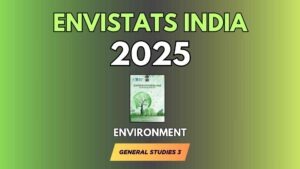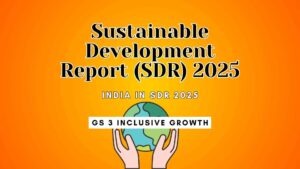EnviStats India 2025- Important UPSC Notes
EnviStats India 2025
📌 In News
Released by: Ministry of Statistics and Programme Implementation (MoSPI)
Date: 5th June 2025 (World Environment Day)
Edition: 8th
Purpose: To present official environmental statistics of India in a structured, globally comparable format.
Framework Used: FDES 2013 (Framework for the Development of Environment Statistics by the United Nations Statistics Division)
🌱 Key Highlights from the Report
🔋 1. Energy Trends
Thermal power generation increased from 7.92 lakh GWh (2013–14) to 13.26 lakh GWh (2023–24).
Renewable energy generation rose drastically from 65,520 GWh to 2.25 lakh GWh during the same period.
Significance: Indicates a transition toward clean energy sources, aligning with India’s Paris Climate Goals.
🐟 2. Fish Production (Blue Economy)
Inland fish production grew from 61.36 lakh tonnes to 139.07 lakh tonnes.
Marine fish output reached 44.95 lakh tonnes.
Significance: Strengthens food security and rural employment through aquaculture.
🌡️ 3. Temperature Trends
The annual mean temperature rose from 25.05°C (2001) to 25.74°C (2024).
Both minimum and maximum temperatures are increasing, suggesting global warming and climate change effects in India.
🌧️ 4. Rainfall Patterns
Year-to-year rainfall remains erratic; no consistent long-term increase or decrease.
Implication: Challenges in monsoon prediction, agriculture planning, and flood/drought preparedness.
🐞 5. Biodiversity: Faunal Species
India is home to 1,04,561 faunal species, including:
22,404 soil species
9,436 freshwater species
5,023 mangrove species
Significance: Reinforces India’s role as a biodiversity hotspot.
💸 6. Environmental Sector Budgeting
Highest expenditure went to Environmental Sustainability: ₹2,433 crore (2021–22).
Agroforestry received the least funds, reflecting imbalanced priorities.
📊 7. New Indicators Added
Ramsar sites, sanitation, transport, and electricity access now included.
Why it matters: Brings a holistic lens to environmental statistics — not just nature, but also human-environment interaction.
🌍 8. Structured Framework (FDES)
The use of FDES 2013 makes the report globally comparable and helps align with SDG tracking.
🧩 Critical Analysis of the Report
✅ Positives
Data-Driven Governance: Helps in evidence-based policymaking for climate, water, and biodiversity issues.
Broader Indicator Base: Incorporates human well-being factors like sanitation and transport.
Supports International Commitments: Helps monitor progress on climate goals (e.g., Paris Agreement).
Strong Biodiversity Focus: India’s soil and aquatic diversity is well represented.
❌ Negatives
No State-Level Rainfall Trends: Limits localized disaster planning.
No Policy Impact Evaluation: Doesn’t explain the causes of trends or effectiveness of current policies.
Outdated Data Sets: Some figures are from years ago, reducing real-time relevance.
No Climate Vulnerability Mapping: Rising temperatures are noted, but no assessment of who or what is most at risk.
🔧 Way Forward: Recommendations
Use Real-Time Monitoring: Employ ISRO’s satellites and IoT-based tools for up-to-date environmental data.
Disaggregate Data: Provide district-wise or state-wise breakdowns to support local governance.
Link with SDGs:
Goal 6 – Clean Water and Sanitation
Goal 7 – Affordable and Clean Energy
Goal 13 – Climate Action
Goal 14 – Life Below Water
Goal 15 – Life on Land
Better Data Visualization: Use dashboards, maps, and infographics to make data accessible for the public, researchers, and students.
🧠 Important Terms Explained (For Beginners)
Thermal Power: Electricity generated using fossil fuels like coal and gas.
Renewable Energy: Power from natural sources like solar, wind, hydro.
Inland Fisheries: Fish farming in freshwater sources like rivers, ponds, lakes.
Marine Fisheries: Fishing in seas and oceans.
GWh (Gigawatt-hour): A unit of energy used to measure electricity generation.
FDES (Framework for Development of Environment Statistics): A global UN guideline to organize and report environmental statistics in a structured manner.
Ramsar Sites: Wetlands of international importance under the Ramsar Convention.
Agroforestry: Integrating trees with farming for ecological and economic benefits.
SDGs (Sustainable Development Goals): 17 global goals adopted by the UN to achieve a better and more sustainable future.
🧾 Conclusion
EnviStats India 2025 is a valuable statistical foundation for environmental governance.
However, for it to be truly impactful, it must evolve into a dynamic, region-specific, and real-time decision-support tool.
India’s future depends on how well we can translate such data into actionable policy and community engagement.
Mains-Based Questions on EnviStats India 2025
🔶 Question 1:
“EnviStats India 2025 marks a shift towards evidence-based environmental policymaking but falls short in addressing regional and real-time challenges.” Critically analyze.
(GS Paper 3 – Environment, Governance)
✅ Model Answer Framework:
Introduction:
EnviStats India 2025, released by MoSPI, is the 8th edition of India’s official environmental statistics report.
It provides a structured dataset covering various ecological, climatic, and sustainability indicators aligned with the UN’s FDES 2013 framework.
Body:
1. Positives – Shift Toward Evidence-Based Policymaking:
Structured and Comparable Data: Enables policy planners to track trends in energy use, biodiversity, and climate change.
Inclusion of Socio-Environmental Indicators: Sanitation, Ramsar sites, electricity access enhance integrated planning.
Supports Global Commitments: Data helps monitor India’s progress toward Paris Agreement and SDG goals.
2. Gaps in Regional and Real-Time Relevance:
No Disaggregated Regional Data: Absence of state-wise rainfall or temperature limits localized response to climate risks.
Lag in Data Timeliness: Several datasets are outdated (e.g., energy data up to 2023–24), limiting real-time responsiveness.
No Impact Analysis: Only raw statistics are presented, without assessment of causality or policy effectiveness.
Inadequate Climate Vulnerability Mapping: Rising temperatures are recorded, but without detailing areas or populations at risk.
Way Forward:
Use ISRO’s satellite and IoT-based monitoring for real-time data collection.
Ensure district and state-level granularity in environmental data.
Integrate predictive analytics and visual dashboards for public engagement and faster decision-making.
Align datasets directly with SDG targets and climate adaptation goals.
Conclusion:
While EnviStats India 2025 is a strong step towards data-driven environmental governance, future editions must focus on granular, real-time, and impact-oriented statistics to enable more effective climate resilience planning.
🔶 Question 2:
Discuss the role of environmental statistics in strengthening India’s climate action and biodiversity protection strategies. Refer to EnviStats India 2025.
(GS Paper 3 – Environment, Biodiversity & Climate Change)
✅ Model Answer Framework:
Introduction:
Environmental statistics are critical for tracking ecological trends, informing policy, and meeting international climate obligations.
EnviStats India 2025, by MoSPI, showcases India’s progress in renewable energy, biodiversity documentation, and temperature shifts.
Body:
1. Role in Climate Action:
Tracks Energy Transitions: Renewable energy growth (from 65,520 GWh to 2.25 lakh GWh) indicates shift away from fossil fuels.
Temperature Monitoring: Annual mean temperature rise (from 25.05°C in 2001 to 25.74°C in 2024) provides basis for adaptation planning.
Helps Monitor SDG 13 (Climate Action) and India’s NDCs under the Paris Agreement.
2. Role in Biodiversity Protection:
Extensive Biodiversity Mapping: Faunal diversity of over 1 lakh species highlights India’s role as a biodiversity-rich nation.
Inclusion of Ramsar Sites: Tracks the health of wetlands, critical for migratory birds and aquatic species.
Supports SDG 14 (Life Below Water) and SDG 15 (Life on Land) through reliable biodiversity data.
3. Informing Policy & International Reporting:
Helps create science-based policies for environmental protection.
Enables transparent reporting to UNFCCC, CBD, and SDG voluntary national reviews.
Limitations to Address:
Lack of real-time data and climate vulnerability mapping.
Absence of cause-effect or impact evaluation reduces policy relevance.
Conclusion:
Environmental statistics like those in EnviStats 2025 are vital tools for India’s ecological governance.
To fully leverage their potential, these statistics must evolve into dynamic, granular, and action-linked datasets.
🔶 Question 3:
What are the key challenges in using environmental statistics for decentralized environmental governance in India? Suggest solutions.
(GS Paper 2/3 – Governance, Environment)
✅ Model Answer Framework:
Introduction:
Environmental governance in India increasingly demands localized and data-backed decision-making.
Reports like EnviStats 2025 provide vital statistics, but there are challenges in their utility for decentralized governance.
Body:
Challenges:
Lack of Regional Disaggregation:
Data is mostly national-level; does not reflect inter-state or district-wise variations.
Local governments lack the granularity needed for planning.
Data Timeliness Issues:
Datasets often published with a lag of 1–2 years.
Reduces real-time response to emerging environmental threats.
Low Accessibility:
Technical language and format hinder use by Panchayats, municipalities, and NGOs.
No Integration with Local Planning Tools:
Environmental data is not linked with State Action Plans on Climate Change (SAPCCs) or District Environmental Plans.
Solutions:
Create District-Level Dashboards: Use GIS, remote sensing, and mobile data to produce localized environmental profiles.
Real-Time Data Collection: Partner with ISRO, CPCB, and IMD for IoT and sensor-based real-time monitoring.
Capacity Building: Train local officials in data interpretation and environmental planning.
Open Data Platforms: Make environmental statistics interactive, visual, and multilingual for broader use.
Conclusion:
For effective decentralized governance, environmental data must become accessible, actionable, and localized.
EnviStats should aim to bridge this gap through a citizen-centric and federated data model.
Prelims Questions based on EnviStats India 2025
-
Stampede Management in India – Important UPSC Notes
A stampede occurred at Chinnaswamy Stadium, Bengaluru, during RCB’s IPL... -
EnviStats India 2025 – Important UPSC Notes
The 8th edition of EnviStats India 2025 was released by... -
Quantum Computing – Important UPSC Notes
Tech giants like Google, IBM, and China’s Jiuzhang have developed... -
Indian Energy Security – Important UPSC Notes
In 2025, India became the 4th largest economy in the... -
Indian Food and Fertiliser Subsidies – Important UPSC Notes
With poverty down to 5.3%, distributing food subsidies to 800... -
India in SDR 2025 – Important UPSC Notes
India in SDR 2025 has ranked 99th, entering the Top... -
Indian FDI Mystery- Important UPSC Notes
India received a 13.7% increase in total FDI (Gross FDI...








